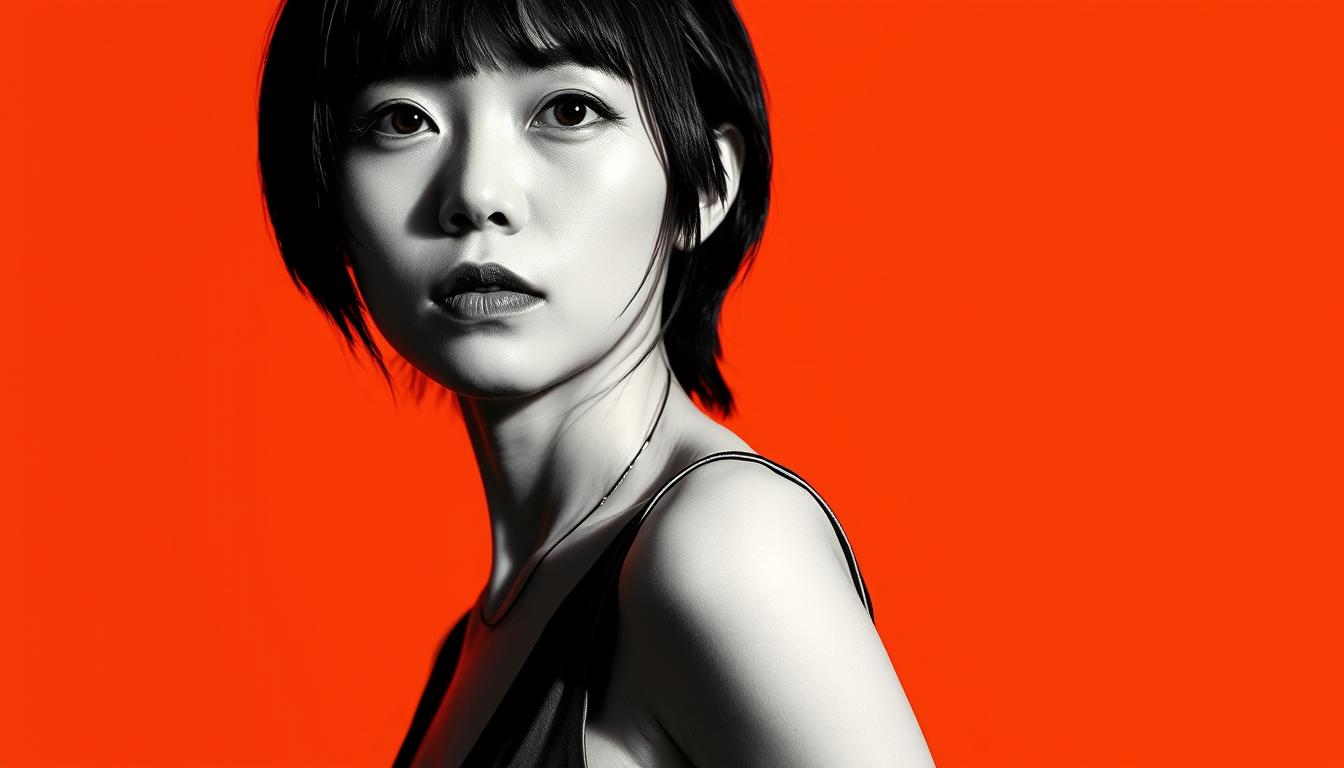This artist arrived in the world on a specific date in 1987. Her early life began in Matsuyama, a city she would later trade for the creative pulse of Tokyo.
She enrolled at Musashino Art University in Kodaira. It was a move that fueled a creative rebellion. By 2007, she found her stage in Kōenji’s intimate live houses.
There, with an acoustic guitar, she built her sound from the ground up. Her voice was a unique instrument—thin yet precise, fragile but fiercely honest.
A major turning point came in 2014. She signed with the label Avex Trax, marking a professional leap. That same year, she married drummer Pierre Nakano.
Their son was born in 2015. For nearly a decade, this person balanced the demands of parenthood with an uncompromising artistic vision. The chapter of their marriage closed quietly in August 2024.
This is the story of a musician who turned personal contradictions into a compelling craft.
Career Origins and Underground Beginnings
Her artistic rebellion found its home not in her birthplace, but in the dive bars of a Tokyo neighborhood. This shift in scenery was a pivotal moment in time.
Matsuyama Roots and the Move to Tokyo
Leaving Matsuyama for Musashino Art University was the first step. Tokyo offered a vast canvas for her creativity.
She soon gravitated to Kōenji. This area was known for its experimental venues.
Life in Kōenji’s Live Houses and Early Performances
By 2007, she was a regular at Muryoku Muzenji. Her early sets were just a voice and an acoustic guitar.
The sound was a unique blend. It had the storytelling of folk music but the raw energy of punk.
After several years, she formed Seiko Oomori & The Pink Tokarev. This band added a powerful rock dimension to her foundation.
It was a crucial evolution. The full band sound gave her music more texture and force.
Critics noted her work challenged the popular idol scene of the time. They compared her bold style to innovators like Jun Togawa.
She created a space for people who wanted something different. Her music was personal, charged, and entirely her own.
Musical Style and Genre Fusion
The musical landscape she created was a deliberate collision of opposites. It challenged the neat categories of the Japanese music industry. Her work became a signature blend of sweet melody and raw power.
She famously described her own sound as “Disneyland in hell.” This phrase perfectly captures the experience. Sugary pop hooks crash into the aggressive energy of rock.
Blending Idol Pop, Punk Rock, and Folk Influences
This fusion was not random. Each genre contributed a vital element to her unique style.
- Idol culture provided a framework of catchy melodies and performative charm.
- Punk rock injected a dose of rebellion, volume, and confrontational energy.
- Folk music offered a way to be intimate and confessional, often before a song erupted into chaos.
She agreed with John Lydon’s idea that the Sex Pistols were a folk band. For her, the lines between rebellion and tradition were meant to be blurred. The fusion was a genuine reflection of her personality.
Ultimately, she believed great music came down to three things. Good melodies, interesting lyrics, and a strong voice. This philosophy made her a pioneer of the “anti-idol” scene, embracing messy authenticity over polished perfection.
Evolution from Anti-Idol to Mainstream Appeal
Two raw, independently released albums in 2013 served as the proving ground for an artist ready to challenge the system.
Independent Releases and Underground Credibility
“Mahō ga Tsukaenai nara Shinitai” and “Zettai Shōjo” established a powerful foundation. These works proved she could create without major label support.
Her live shows across Tokyo built a dedicated following. A 2013 appearance at the Tokyo Idol Festival showcased her unique approach to a wider audience.
Transition After Signing with Avex Trax
Signing with Avex Trax in 2014 marked a significant pivot. It offered a new way to reach broader listeners while maintaining artistic integrity.
Her first major label album “Sennō” incorporated electronic elements and polished production. The transition showed evolution could coexist with authenticity.
Over time, subsequent albums continued this adaptive approach. Each release demonstrated that mainstream success didn’t require compromising vision.
Stage Persona and Visual Impact
Visual disruption became her signature weapon against predictable performance conventions. Her Rock In Japan festival appearance exemplified this approach perfectly.
She took the stage alone, acoustic guitar in hand. But her nurse outfit dripped with fake blood, creating immediate tension. The gentle fingerpicking would suddenly erupt into violent thrashing.
Innovative Fashion and Shock Value Performances
This was no random shock tactic. She deliberately blended cute and grotesque elements. The kanji on her outfit reading “The end” declared her mission clearly.
She wanted to kill off boring performance stuff. Traditional folk musicians just standing still bothered her. Movement and unexpected things made the experience fun.
Her approach forced people to engage actively. They couldn’t settle into passive consumption. Each visual choice served a purpose.
| Traditional Folk Performance | Her Approach | Audience Impact |
|---|---|---|
| Static, somber presentation | Dynamic, unpredictable movement | Creates tension and anticipation |
| Conventional stage attire | Contradictory visual statements | Forces active interpretation |
| Predictable musical flow | Deliberate sonic contrasts | Prevents passive listening |
| Serious artistic demeanor | Playful yet confrontational tone | Challenges expectations |
Even domestic activities like baking became artistic statements. Hello Kitty cakes mixed with subversion showed her unique way of working. People left her shows transformed, having experienced something entirely new.
The artist made sure every performance contained a bit of the unexpected. She believed great art should make you question what you’re seeing. That philosophy defined her entire visual approach.
Exploring Seiko Oomori’s Artistry
The artistry is built on a refusal to be easily defined. It thrives on contradiction, creating a body of work that feels both playful and profound.
Every song carries a unique fingerprint. This makes her catalog feel alive and impossible to reduce to a single idea.
Iconoclastic Performance Techniques and Contrasts
Contrast is the engine of her creative process. She deliberately pits opposing forces against each other to create tension and meaning.
- Sweet, melodic pop hooks collide with aggressive, punk-inspired energy.
- Quiet, intimate moments suddenly shatter into loud, cathartic explosions.
- Visually cute idol imagery is twisted into something darker and more unsettling.
This approach gives each track a distinctive bittersweet vibe. Even the most upbeat songs hold a touch of melancholy.
The sparest ballads, in contrast, contain a surprising emotional power. She pulls off these stylistic left-turns with conviction.
Mixing Cute Idol Imagery with Dark, Bold Themes
Her work actively challenges expectations. She uses familiar pop culture symbols but subverts their typical meaning.
Pink, sparkly aesthetics might frame lyrics exploring morbid or complex themes. This forces the audience to reconcile the contradiction.
Listening feels like a conversation with a provocative thinker. New ideas and shifts in tone constantly interrupt any simple conclusion.
Oomori has stated she dislikes being pinned down. This restless energy is a deliberate artistic choice, ensuring her music remains unpredictable.
Influence of Japanese Culture and Idol Trends
The landscape of Japanese music in the early 2010s was heavily defined by a specific phenomenon. Mainstream idol culture promoted a vision of perfection. It was a world of manufactured stars with polished images.
Counteracting Mainstream Idol Stereotypes
Oomori did not simply reject this system. She engaged with it on her own terms. Her strategy involved appropriating the very aesthetics she questioned.
She saw the appeal of idol pop, comparing its energy to a sparkly Disneyland. It was music designed to make people happy. Her goal was similar, but her path was completely different.
Fans noticed this playful mockery and enjoyed it. She leaned into the ambiguity. Her use of cute outfits and kawaii culture always had a sharp edge.
This approach made the audience part of the art. People had to decide for themselves if her comments were sincere or sarcastic. She created a space for critical enjoyment.
Her work influenced a lot of alternative scenes. It helped pave the way for groups that blended cute and heavy sounds. She proved you could critique something by lovingly twisting its tools.
Discography Highlights and Album Impact
Eight studio albums trace a decade-long journey of sonic reinvention. Each record acts as a distinct chapter, refusing to settle into a single kind of music.
This evolution began with two raw 2013 releases. They captured the artist at her most vulnerable and uncompromising.
The 2014 major-label debut “Sennō” was a critical breakthrough. Critics hailed it as a hybrid masterpiece. The album blended electronic pop, punk, and folk into a surprisingly cohesive gem.
Subsequent releases pushed boundaries further. “Kitixxxgaia” tackled gender politics head-on, a politicized magnum opus. “Kusokawa Party” showcased powerful vocals over synth-heavy glam metal.
The table below highlights key transformative albums in her catalog.
| Album | Artistic Focus | Critical Reception |
|---|---|---|
| “Sennō” (2014) | Genre fusion; polished production | Breakthrough; immediately entertaining |
| “Kitixxxgaia” (2017) | Societal critique; political themes | Ambitious but overlong |
| “Kusokawa Party” (2018) | Vocal performance; glam metal | Energetic; best vocals to date |
Later works continued this pattern of experimentation. The 2024 album “This Is Japanese Girl” served as a final statement. It reaffirmed a commitment to challenging expectations until the very end.
The discography proves an artist who treats every album as a new canvas. She was never content to repeat past successes.
Lyrical Themes and Songwriting Brilliance
The words she wrote were a world of their own. A place where light and shadow danced together. This lyrical landscape was a key part of her artistic power.
Critics praised her as an excellent lyricist. Her discography has a very directed arc. This narrative thread elevates even her weaker tracks.
Dark Themes Versus Playful and Provocative Lyrics
Her lyrics toggle between dark confessions and playful provocation. A single song could keep listeners off-balance. Titles like “If I Can’t Use Magic I Want To Die” signal a willingness to voice desperation.
Other songs, like “Zettai Kanojo,” celebrate female friendship. They reject male-centric narratives in pop music. When asked about sexual themes in her work, she deflected with humor.
She insisted interpretation was the listener’s responsibility. “It’s all in your head,” was her reply. This playful deflection kept control of the narrative in her hands.
She even preemptively addressed personal gossip in her online bio. Listing “All my ex-boyfriends” as a dislike was a strategic joke. It shut down potential comments before they started.
Cultural Commentary in Her Songwriting
Her songwriting carries a sharp cultural edge. It often critiques idol culture and gender expectations. The pressure to conform is a recurring theme.
This commentary rewards close reading. Translating her songs reveals layers of meaning. Even accessible pop tracks become richer and more resonant.
She built a lot of meaning into her work. Each album complicated ideas from the last. This created a sophisticated and evolving body of songs.
Collaborations and Contributions to the J-Pop Scene
Collaboration became a vital extension of her artistic philosophy, connecting her with like-minded innovators. This approach expanded her impact beyond solo work.
She embraced the role of mentor within the alternative pop scene. Her partnerships demonstrated a generous approach to creative community building.
Working with Other Innovators and Idol Groups
In 2018, she launched the idol group ZOC, serving as both performer and producer. This project blurred traditional roles in Japanese music.
The 2021 double-album “PvP” showcased her production vision. She collaborated with Kenta Sakurai to expand the band’s sonic palette.
Her work extended to producing MAPA’s debut album “Shitennou” for former BiS member Megumi Koshouji. This demonstrated her influence across the pop landscape.
The collaboration “Hikokuminteki Hero” with Noko of Shinsei Kamattechan revealed strong creative chemistry. Both artists shared an iconoclastic approach to their work.
| Collaboration | Role | Creative Contribution |
|---|---|---|
| ZOC idol group | Performer & Producer | Blurred artist/producer boundaries |
| MAPA’s “Shitennou” | Album Producer | Mentored emerging talent |
| “Hikokuminteki Hero” | Featured Artist | Shared creative energy with peer |
Fans appreciated her willingness to share the spotlight. She used her platform to elevate other voices in the scene.
These partnerships cemented her role as connective tissue in Japan’s experimental pop underground. Her collaborative work revealed a deep understanding of pop mechanics.
Public Persona, Personal Life, and Media Perspectives
Behind the explosive stage persona existed a private life carefully guarded from public view. The artist maintained strict boundaries between her creative work and personal world.
Marriage, Family Life, and Recent Personal Changes
In 2014, Oomori Seiko announced her marriage without revealing her partner’s identity. She kept this part of her life private for years. Fans received only glimpses of her personal world during this time.
The couple welcomed their son the following year. Balancing motherhood with an intense creative schedule defined this period of her life. She once declared that “marriage is not rock and roll,” highlighting the tension she felt between domestic life and artistic identity.
In 2020, she finally confirmed Pierre Nakano as her husband. This gave fans a rare look into her personal world. The revelation came after six years of marriage.
August 18, 2024, marked a significant date in her personal story. On what would have been their tenth anniversary, the couple announced their divorce. They shared the news quietly through social media.
This forward-moving approach reflects her philosophy toward creative work too. She treats finished albums as burials, saying goodbye to each project. The artist constantly reinvents herself, rejecting nostalgia for what comes next.
Final Reflections on Seiko Oomori’s Lasting Legacy
In the noisy landscape of Japanese pop, one voice cut through with a clarity that was both sweet and unsettling. Critics called Oomori the best pop artist of the 2010s, a bold claim backed by fearless experimentation. Some even rated her career above established icons.
She asked to be remembered as “extremely noisy,” even when playing acoustic guitar alone. Songs like “Zettai Kanojo” and “Magic Mirror” became touchstones. They felt like manifestos and pop tracks at once.
Her legacy shows that pop music can be intellectually rigorous and ridiculously fun. Girls found themselves reflected in her work as active participants in a joyful rebellion. She proved weirdness is a kind of power. Her music feels like a conversation that never ends.




